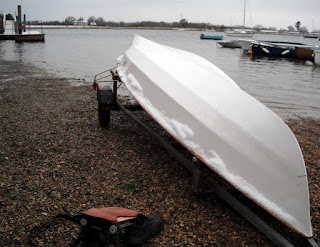This lot of wood is a kit boat for a Woods Bee that Alec Jordan cut for me a loooong time ago, which I have failed to even start to build. It should be a rowing/sailing dinghy by now, looking something like this:
Progress of a sort has been made - one of the sheets of exterior grade ply that the kit came packed in were made into the washing-up bowl shaped boat in the front there. As Simbo, she has won me the title of Biggest Bloke in the Smallest Boat 2010.
So I hereby resolve that the kit will be built in 2011.
Although first I have to transform the other packing sheet into a cordless-drill-powered boat for the Water Craft competition at Beale Park (I will use another of Hannu's brilliant designs, Prism).
 And then there is this, which will occupy a good deal of my time I hope >>>------->
And then there is this, which will occupy a good deal of my time I hope >>>------->And there is another building project looming, training for the Great River Race, and I am hoping to cash in on some invitations to go sailing this year as well.
So perhaps 2012 is a more realistic aim.....


































 In order to help make the vision a reality, we helped the inventor design, model, prototype and manufacture his new oar handle. From material selection (carbon fiber, fiberglass, or aluminum?) to part selection, we worked with the inventor to find the best path forward.
In order to help make the vision a reality, we helped the inventor design, model, prototype and manufacture his new oar handle. From material selection (carbon fiber, fiberglass, or aluminum?) to part selection, we worked with the inventor to find the best path forward.